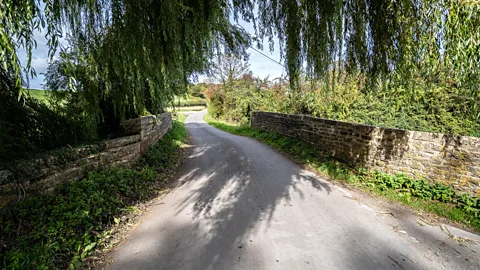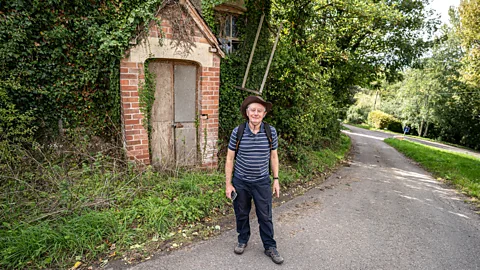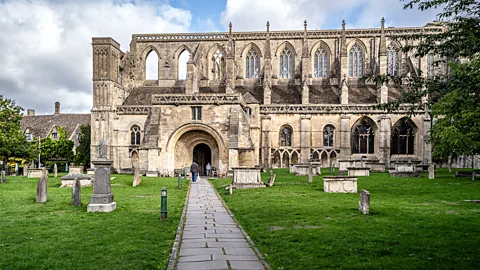A new trail honouring England's overlooked king
 Richard Collett
Richard CollettThe Athelstan Pilgrim Way, a new 100-mile trail in Wiltshire, recalls the reign of England's first king 1,100 years after his crowning.
If you were asked to name a famous English monarch, maybe you'd pick Richard the Lionheart, Henry VIII or Queen Elizabeth II. Few would consider Æthelstan, Alfred the Great's grandson, but he was the first to rule over a united England.
England's first true king (whose anglicised name is Athelstan) was buried in Malmesbury, a hilltop town surrounded by rural Wiltshire's rolling countryside, where he's never been forgotten. Now, the new Athelstan Pilgrim Way – a 100-mile-long hiking and cycling trail beginning at Malmesbury Abbey – sets out to remember him, 1,100 years after his crowning.
Launched in June 2024, the route links 36 churches in North Wiltshire, and is reviving the king's lost legacy. It was created as part of the wider Athelstan 1,100 celebrations, which included archaeological digs, history lectures and an 11-day pilgrimage in August to Kingston-upon-Thames, approximately 100 miles away, where Æthelstan was officially crowned in 925.
 Richard Collett
Richard CollettThe Athelstan Pilgrim Way doesn't go to Kingston-upon-Thames but is instead divided into six circular walks and two long cycling loops that traverse Malmesbury's surrounding countryside. The first stage starts in Malmesbury Abbey, where I find Æthelstan's tomb beneath high Norman arches, and later the ruler's namesake museum.
"I'd never really heard of Æthelstan until I moved here from Manchester," Anne Goodyer, a volunteer at Malmesbury's Athelstan Museum, which tells the forgotten king's fascinating story, told me. "But this is the heartland of English history; he's remembered very, very fondly here."
While every English school child can tell you the story of Alfred the Great burning the cakes, his grandson's exploits are typically consigned to dusty library shelves. When he was born around 894AD, the land now known as England was divided between warring Anglo-Saxon kingdoms and Viking invaders. Alfred, King of Wessex, dreamed of uniting the English-speaking peoples of Britain to defeat the Norse usurpers. After laying the foundations for an ambitious nation building project, his grandson, who ruled from 924 to 939AD, became the first king of a united territory after conquering the Viking-controlled kingdom of Jorvik (York) that occupied much of northern England.
"For the first time in history, the ethnic English peoples were all ruled by one king," explained local historian and author Tony McAleavy, who explores the history of Æthelstan's supposed resting place in his book, Malmesbury Abbey 670-1539. "After taking the north in 927, he could claim to rule over all the people of Anglo-Saxon descent, or the English as they began calling themselves."
 Richard Collett
Richard CollettAn intensely pious king, Æthelstan's reverence for Saint Aldhelm, the 8th-Century Abbot of Malmesbury, was one reason he wished to be buried here when he died in 939. The other reason, according to McAleavy, was political. While Æthelstan's ancestors were buried in Winchester, the traditional seat of Wessex royalty, Malmesbury sits right on the border between the once-warring kingdoms of Wessex and Mercia. A symbolic signal, even in death, that Æthelstan had been king of all the English.
I met David Pope, who helped develop the Athelstan Pilgrim Way's routes, inside the abbey. He'd recommended that we walk part of the first and second stages together (a 13-mile loop to/from Malmesbury), and before we set off, he presented me with a "Pilgrim Passport" that hikers stamp in each of the trail's 36 churches, starting here in Malmesbury Abbey.
"Some are interested in history. For others, it's a spiritual journey, or a way to escape the humdrum of daily life," he said, after explaining how he'd walked each of the trail's 100 miles before launch to ensure it was safe and navigable. "Even though it's a church initiative, it's not evangelism. People take what they want from it; they discover the routes at their own pace."
Adding to Æthelstan's mysterious aura, Pope also told me how the stone tomb, where I'd just made my own historical rather than spiritual pilgrimage, is empty. In the 12th Century, the king was moved here from the older Anglo-Saxon abbey, but he was later lost, his bones likely scattered during Henry VIII's Reformations or smashed during the English Civil War when Malmesbury became a battlefield. Locals like Pope hope that one day Æthelstan will make a grand resurrection, perhaps resurfacing beneath a car park like Richard III in Leicester, but until then, no one's the wiser as to where he might actually be.
 Richard Collett
Richard CollettAs we set off through Malmesbury's sandstone streets, Pope explained how he'd been drawn to this project after working on a similar pilgrimage route in his native Wales during lockdown. He added that while the Athelstan Pilgrim Way draws on the old king's heritage and links to Malmesbury, the idea of a continuous trail, linking the abbey to all of its surrounding churches, was inspired by Hilary Peters, an avid hiker and pilgrim, who sadly passed away in 2022, before she saw her project realised.
Pope believes Æthelstan would have approved of the pilgrim route they've created, but he isn't quite so fond of the king's exploits as others in Malmesbury. "Because I'm Welsh," he said with a chuckle as we strolled down a winding country lane lined with brambles and blackberries. "I certainly wouldn't have approved of Æthelstan if I lived in the 10th Century."
Walking the Athelstan Pilgrim Way
Length: Around 100 miles, divided into six circular walking routes plus two cycle loops.
Start point: Malmesbury Abbey, Wiltshire. Pick up a Pilgrim Passport here to collect stamps at churches along the way.
Navigation: Trails are not yet waymarked; detailed route booklets are available from the Athelstan Museum and Abbey shop or can be downloaded here.
Church access: Many churches are open or have stamp boxes in porches, though not all are staffed at all times.
Best time to go: Late spring to early autumn for longer days and drier paths for walking.
Pope guided me as far as Brokenborough, a village of 200 inhabitants where we arrived outside the 13th-Century Church of St John the Baptist after a 45-minute walk from Malmesbury Abbey. Here he reminded me that there are always two sides to every story. Æthelstan victories united the English, but came at great cost to Britain's other peoples, including the Welsh and Scots.
More like this:
• Kingston-upon-Thames: London's town of kings and queens
After receiving the second stamp in my Pilgrim Passport, we were joined in Brokenborough's grassy cemetery by Dr Sheona Beaumont, the Athelstan Pilgrim Way's "Artist in Residence". "Pilgrimages are back in fashion," she said happily, before explaining how she is photographing the landscapes, churches and communities along the 100-mile route as she slowly walks its length over the next two or so years. "It's so interesting to work on a project so many people in Malmesbury are so excited about," she added. "Even if they're not religious, people identify with the local churches on the route. They're part of our landscapes. They're part of our shared history."
Pope and Beaumont left me on the edge of Brokenborough so I could hike the next few miles solo, and I soon found myself on a suspiciously straight road. The Fosse Way, a Roman Road stretching from Exeter to Lincoln, took me to Foxley, where I picked up my third stamp in a medieval church mentioned in William the Conqueror's 11th-Century Domesday Book. I picked up my fourth stamp down the road in tiny Bremilham Church, which, at 12 sq ft, is the smallest church (in use) in England.
 Richard Collett
Richard CollettAs I finished my day's hiking back in Malmesbury, I realised it's the minutiae of local history mixing with rural landscapes and historic churches that make the Athelstan Pilgrim Way as intriguing as its namesake king. I'd also begun noticing Æthelstan's legacy all around Malmesbury itself.
When I'd visited Athelstan Museum that morning, Goodyer had listed all the Æthelstan connections in Malmesbury. The long list included the Athelstan Care Home, streets with names like Athelstan Court, and the Warden & Freemen of Malmesbury, a local society tracing its lineage back to Athelstan himself. There was once, she told me, a local magician named the Great Athelstaniao.
Æthelstan has never been "rediscovered" here, because he's never been forgotten. For those of us who didn't grow up knowing who England's first true king was, however, the Athelstan Pilgrim Way is a beautiful introduction.
--
CORRECTION: This story has been updated from an earlier version.
If you liked this story, sign up for The Essential List newsletter – a handpicked selection of features, videos and can't-miss news, delivered to your inbox twice a week.
For more Travel stories from the BBC, follow us on Facebook and Instagram.
